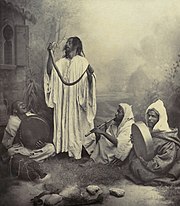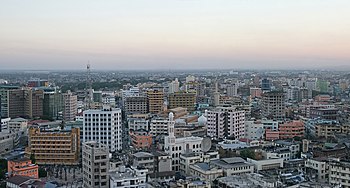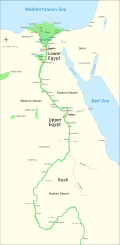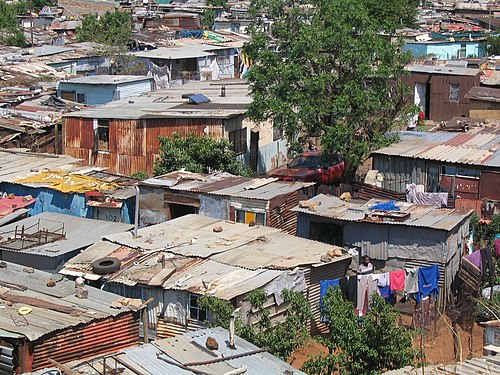Portal:Africa



Africa is the world's second-largest and second-most populous continent after Asia. At about 30.3 million km2 (11.7 million square miles) including adjacent islands, it covers 20% of Earth's land area and 6% of its total surface area. With nearly 1.4 billion people as of 2021, it accounts for about 18% of the world's human population. Africa's population is the youngest among all the continents; the median age in 2012 was 19.7, when the worldwide median age was 30.4. Based on 2024 projections, Africa's population will reach 3.8 billion people by 2099. Despite a wide range of natural resources, Africa is the least wealthy continent per capita and second-least wealthy by total wealth, ahead of Oceania. Scholars have attributed this to different factors including geography, climate, corruption, colonialism, the Cold War, and neocolonialism. Despite this low concentration of wealth, recent economic expansion and a large and young population make Africa an important economic market in the broader global context. Africa has a large quantity of natural resources and food resources, including diamonds, sugar, salt, gold, iron, cobalt, uranium, copper, bauxite, silver, petroleum, natural gas, cocoa beans, and.
Africa straddles the equator and the prime meridian. It is the only continent to stretch from the northern temperate to the southern temperate zones. The majority of the continent and its countries are in the Northern Hemisphere, with a substantial portion and a number of countries in the Southern Hemisphere. Most of the continent lies in the tropics, except for a large part of Western Sahara, Algeria, Libya and Egypt, the northern tip of Mauritania, and the entire territories of Morocco, Ceuta, Melilla, and Tunisia, which in turn are located above the tropic of Cancer, in the northern temperate zone. In the other extreme of the continent, southern Namibia, southern Botswana, great parts of South Africa, the entire territories of Lesotho and Eswatini and the southern tips of Mozambique and Madagascar are located below the tropic of Capricorn, in the southern temperate zone.
Africa is highly biodiverse; it is the continent with the largest number of megafauna species, as it was least affected by the extinction of the Pleistocene megafauna. However, Africa also is heavily affected by a wide range of environmental issues, including desertification, deforestation, water scarcity, and pollution. These entrenched environmental concerns are expected to worsen as climate change impacts Africa. The UN Intergovernmental Panel on Climate Change has identified Africa as the continent most vulnerable to climate change.
The history of Africa is long, complex, and varied, and has often been under-appreciated by the global historical community. In African societies the oral word is revered, and they have generally recorded their history via oral tradition, which has led anthropologists to term them oral civilisations contrasted with literate civilisations. African historiography became organized at the academic level in the mid-20th century, and saw a movement towards utilising oral sources in a multidisciplinary approach, culminating in UNESCO publishing the General History of Africa from 1981, edited by specialists from across the continent. are still tasked with building the institutional frameworks, incorporating African epistemologies, and representing an African perspective. (Full article...)
Selected article –
The Saint-Sylvestre coup d'état was a coup d'état staged by Jean-Bédel Bokassa, commander-in-chief of the Central African Republic (CAR) army, and his officers against the government of President David Dacko on 31 December 1965 and 1 January 1966. Dacko, Bokassa's cousin, took over the country in 1960, and Bokassa, an officer in the French army, joined the CAR army in 1962. By 1965, the country was in turmoil—plagued by corruption and slow economic growth, while its borders were breached by rebels from neighboring countries. Dacko obtained financial aid from the People's Republic of China, but despite this support, the country's problems persisted. Bokassa made plans to take over the government; Dacko was made aware of this, and attempted to counter by forming the gendarmerie headed by Jean Izamo, who quickly became Dacko's closest adviser.
With the aid of Captain Alexandre Banza, Bokassa started the coup New Year's Eve night in 1965. First, Bokassa and his men captured Izamo, locking him in a cellar at Camp de Roux. Bokassa's men then occupied the capital, Bangui, and overpowered the gendarmerie and other resistance. After midnight, Dacko headed back to the capital, where he was promptly arrested, forced to resign from office and then imprisoned at Camp Kassaï. According to official reports, eight people were killed during the takeover. By the end of January 1966, Izamo was tortured to death, but Dacko's life was spared because of a request from the French government, which Bokassa was trying to satisfy. Bokassa justified the coup by claiming he had to save the country from falling under the influence of communism, and cut off diplomatic relations with China. In the early days of his government, Bokassa dissolved the National Assembly, abolished the Constitution and issued a number of decrees, banning begging, female circumcision, and polygamy, among other things. Bokassa initially struggled to obtain international recognition for the new government. However, after a successful meeting with the president of Chad, Bokassa obtained recognition of the regime from other African nations, and eventually from France, the former colonial power. (Full article...)
Featured pictures –
Did you know (auto-generated) -

- ... that Louis W. Roberts was among the highest ranking African-American space program staff at NASA while the Apollo program was underway?
- ... that South African politician Speedy Mashilo was kidnapped for seven hours?
- ... that Michigan defensive end Eyabi Okie, ranked number 3 in the 2018 college football recruiting class, changed his surname from "Anoma" to recognize his mother who lives in Africa?
- ... that Frank Jeremiah Armstrong, the first African-American graduate of Cornell College, became an assistant to Booker T. Washington?
- ... that in 1948, Thomas Yarborough became the first African American to be elected as a city council member in California?
- ... that when the pastor of an African-American church bought the El Dorado, one newspaper wrote that "its occupants are white, and were white"?
Categories
Selected biography –

Haile Selassie I (Ge'ez: ቀዳማዊ ኀይለ ሥላሴ Qädamawi Ḫäylä Śəllase, lit. 'Power of the Trinity'; born Tafari Makonnen; 23 July 1892 – 27 August 1975) was the Emperor of Ethiopia from 1930 to 1974. He rose to power as the Regent Plenipotentiary of Ethiopia (Enderase) under Empress Zewditu between 1916 and 1930. Widely considered to be a defining figure in modern Ethiopian history, he is accorded divine importance in Rastafari, a relatively new Abrahamic religion that emerged in the Colony of Jamaica in the 1930s. A few years before he began his reign over the Ethiopian Empire, Selassie defeated Ethiopian army commander Ras Gugsa Welle Bitul, who was the nephew of Empress Taytu Betul, during the Battle of Anchem. He belonged to the Solomonic dynasty, which was founded by Emperor Yekuno Amlak in 1270; Amlak's successors claimed that he was a lineal descendant of Menelik I, the legendary Emperor of Ethiopia who was supposedly born to King Solomon and Queen Makeda of the Kingdom of Israel and the Kingdom of Sheba, respectively. Modern historians regard the Solomonic linage claim as an unfounded myth created by Yekuno Amlak to justify wresting power from the Zagwe Dynasty.
Selassie attempted to modernise Ethiopia by introducing a series of political and social reforms, including the 1931 constitution and the abolition of slavery. He led the failed effort to defend Ethiopia during the Second Italo-Ethiopian War and was consequently exiled in the United Kingdom after the beginning of the Italian occupation of East Africa. In 1940, he travelled to Anglo-Egyptian Sudan to assist in coordinating the Ethiopian struggle against Fascist Italy, and was able to return home following the East African campaign of World War II. He later dissolved the Federation of Ethiopia and Eritrea, which was established by the United Nations General Assembly in 1950, and annexed Eritrea as one of Ethiopia's provinces, while also fighting to prevent Eritrean secession. (Full article...)
Selected country –
 |
 |
||

| |||
Guinea-Bissau, officially the Republic of Guinea-Bissau (Portuguese: República da Guiné-Bissau), is a country in western Africa, and one of the smallest nations in continental Africa. It is bordered by Senegal to the north, Guinea to the south and east, and the Atlantic Ocean to its west. Formerly the Portuguese colony of Portuguese Guinea, the name of its capital, Bissau, was added to the country's official name upon independence in order to prevent confusion between itself and the Republic of Guinea. Portuguese, the official language, is spoken by only 14% of the population.
The protracted liberation war against Portugal brought tremendous damage to the country’s economic infrastructure. The civil war that took place in 1998 and 1999 and a military coup in September 2003 again disrupted economic activity. Guinea-Bissau is one of the world's poorest countries, with more than two-thirds of its population living below the poverty threshold. The economy depends mainly on agriculture and fishing, and cashew nuts are its major exports. (Read more...)
Selected city –

Brazzaville (French pronunciation: [bʁazavil], Kongo: Ntamo, Ntambo, Kintamo, Kintambo, Tandala, Mavula; Teke: M'fa, Mfaa, Mfa, Mfoa) is the capital and largest city of the Republic of the Congo (Congo Republic). Administratively, it is a department and a commune. Constituting the financial and administrative centre of the country, it is located on the north side of the Congo River, opposite Kinshasa, the capital city of the Democratic Republic of the Congo (DR Congo).
The population of the capital is estimated to exceed 2.1 million residents, comprising more than a third of the national populace. Some 40% are employed in non-agricultural professions. During World War II, Brazzaville served as the de facto capital of Free France between 1940 and 1942. (Full article...)
In the news
- 12 February 2024 –
- Two boats collide on the Congo River near Kinshasa, Democratic Republic of the Congo; with the death toll remains unclear. (AP)
- 11 February 2024 – 2023 Africa Cup of Nations
- In association football, hosts Ivory Coast win their third Africa Cup of Nations by defeating Nigeria 2–1 in the final. Sébastien Haller scores the winning goal in the 81st minute. (The Guardian)
- 10 February 2024 – Somali civil war
- Four Emirati soldiers and a Bahraini military officer are killed, while ten other people are injured, when a soldier opens fire at a military base in Mogadishu, Somalia, before being killed in the ensuing shootout. Al-Shabaab claims responsibility. (AP)
- 10 February 2024 –
- A Eurocopter EC130 helicopter crashes near Nipton, California, United States, killing all the six people on board, including Nigerian banker Herbert Wigwe. (CBS News)
- 10 February 2024 – 2023–2024 Senegalese protests
- Violent protests occur in Senegal following an announcement by President Macky Sall that presidential elections have been delayed from February 25 to December 15. (Sky News)
- 9 February 2024 –
- At least 18 people are killed during a collision between a bus and a truck on a road in Kinshasa, Democratic Republic of the Congo. (AP)
Updated: 16:33, 14 February 2024
General images -
Africa topics
More did you know –
- ... that at approximately 5,000 years old, the Lothagam North Pillar Site is thought to be the earliest and largest monumental cemetery in eastern Africa?
- ... that a 2020 study found that African countries which allowed foreign funding of NGOs had a higher voter turnout?
- ... that Essop Moosa, who was of Indian origin, became the first non-white player to play for an all-white soccer team in South Africa, appearing under a pseudonym?
- ... that the Seventh German Inner Africa Research Expedition served as cover for a secret First World War espionage mission?
Related portals
Major Religions in Africa
North Africa
West Africa
Central Africa
East Africa
Southern Africa
Associated Wikimedia
The following Wikimedia Foundation sister projects provide more on this subject:
-
Commons
Free media repository -
Wikibooks
Free textbooks and manuals -
Wikidata
Free knowledge base -
Wikinews
Free-content news -
Wikiquote
Collection of quotations -
Wikisource
Free-content library -
Wikispecies
Directory of species -
Wikiversity
Free learning tools -
Wikivoyage
Free travel guide -
Wiktionary
Dictionary and thesaurus






















































































